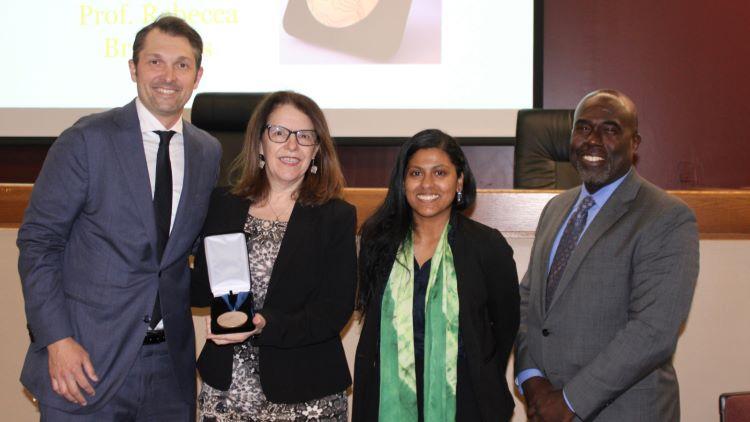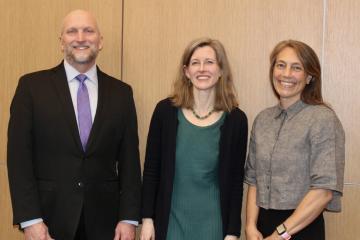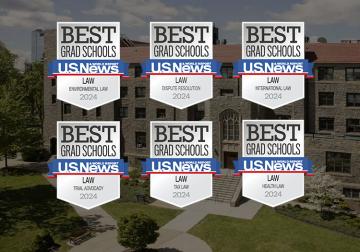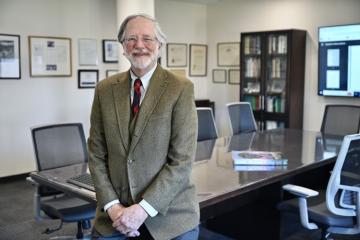Environmental Justice and Human Rights Scholar Professor Rebecca Bratspies Delivers Annual Lloyd K. Garrison Lecture on Environmental Law

Professor Rebecca Bratspies delivered the Annual Lloyd K. Garrison Lecture on Environmental Law on Tuesday, April 16 on "Mapping Injustice: Race, Place, and Environment in New York City." The Lloyd K. Garrison Lecture on Environmental Law was established in memory of Lloyd K. Garrison in 1995. Professor Rebecca Bratspies currently serves as a Visiting Professor of Environmental Law and Haub Visiting Scholar at the Elisabeth Haub School of Law at Pace University. She is also a Professor at CUNY School of Law, where she is the founding director of the Center for Urban Environmental Reform. While at Haub Law, Professor Bratspies is teaching Administrative Law and a Health and the Environment seminar.
Dean Horace E. Anderson Jr. provided the audience with the background of the Annual Lloyd K. Garrison Lecture on Environmental Law and the importance of the lecture to the Haub Law community. Associate Director of Environmental Law Programs & Adjunct Professor at Haub Law, Achinthi Vithanage, introduced Professor Rebecca Bratspies. During her introduction, Professor Vithanage noted Professor Bratspies’ impressive background and the impact she has had on her personally and on the larger environmental law community. Professor Vithanage noted that Professor Bratspies is a well-known environmental justice scholar, a widely published and cited scholar, a human rights advocate, a comic book author, a dedicated educator, an engaged member of the legal profession and academy, a resident historian, a mentor for young academics, a compassionate colleague, and more. After the heartfelt introduction concluded, Gilbert and Sarah Kerlin Distinguished Professor of Environmental Law and Associate Dean of Environmental Law Programs and Strategic Initiatives Jason Czarnezki presented Professor Bratspies with the Garrison Award and Medal.
Professor Bratspies started her lecture by noting that her academic interest focuses on “infrastructure and how the way that we build our city impacts communities and in particular the way that we distribute the benefits and burdens among and between communities.” Professor Bratspies focused her lecture on Environmental Justice, which she describes as having at least two rough components: “fair treatment, a substantive outcome” and “meaningful involvement,” which can be described as a procedural component. She used these components throughout her lecture to discuss the “highly racialized inequality” that exists today, how we got here, and what we can do about it. Professor Bratspies spoke of the role that lawyers play, where “identifying problems as lawyers is only the start, our job is how to move forward and how to solve problems, not just to point them out.”
Professor Bratspies chronicled the history of New York, starting with the 1890’s, and the evolution of housing in New York from single-family to tenement style buildings and the progression of events and laws and agencies. Throughout her lecture, Professor Bratspies utilized the visual tools of maps to display the evolution of structural racism. As she detailed the evolution of New York and structural racism, Professor Bratspies came to the recent map showing New York City’s Environmental Justice Areas, which was produced with advisement by the Environmental Justice Advisory Board, which Professor Bratspies sits on. She noted the importance that this map will play in New York City making a change and dismantling the system to build a fairer one, which will be aided by the recently passed environmentally focused laws that are helping to create a better environmental future for all. She concluded her lecture discussing several current examples of ways that actual change is being moved forward and overburdened communities’ needs and desires are being met. One example includes the closing of Rikers Island and the proposition for Renewable Rikers. Professor Bratspies worked with environmental justice advocates and the Close Rikers Coalition to propose that when Rikers is closed that several things happen, including dedicating a portion of the Island to large scale solar energy, to building a modern wastewater treatment facility, to removing polluting infrastructure from historically overburdened communities, and importantly to ensure these changes happen with the participation and involvement by those most impacted by mass incarceration.
Professor Bratspies has written scores of law review articles which have been published in a variety of prestigious publications. Her most recent book Naming Gotham: The Villains, Rogues and Heroes Behind New York Place Names, won the New York Public Historians 2023 award for Excellence in Local History. Her co-authored textbook Environmental Justice: Law Policy and Regulation is used in schools across the country. Professor Bratspies is perhaps best known for The Environmental Justice Chronicles—her award winning environmental justice comic books Mayah’s Lot, Bina’s Plant, and Troop’s Run, made in collaboration with artist Charlie LaGreca-Velasco. EPA recognized this work with the 2023 Clean Air Act Award for Excellence in Education/Outreach.
Professor Bratspies is a member-scholar with the Center for Progressive Reform, a board member of the Environmental Law Collective, and a member of the NYC Bar Environmental Committee. ABA-SEER honored her work with its 2021 Commitment to Diversity and Justice Award. She was named the Center for International Sustainable Development Law’s 2022 International Legal Specialist for Human Rights Award, and her environmental justice advocacy has been awarded the PSC-CUNY “In It Together” Award, and the Eastern’ Queens Alliance’s Snowy Egret Award. In 1994-95, she was a Luce Scholar seconded to the Republic of China Environmental Protection Administration in Taipei, Taiwan. Before that, she served as a law clerk to the Honorable C. Arlen Beam on the Eighth Circuit Court of Appeals. Professor Bratspies holds a JD cum laude from the University of Pennsylvania, and a BA in Biology from Wesleyan University.
After the lecture, audience members had an opportunity to comment and ask questions and a reception immediately followed the Garrison Lecture.
WATCH THE LECTURE
Lloyd K. Garrison Lecture History
Over forty-five years ago, Lloyd K. Garrison and his associate, Albert K. Butzel, of Paul, Weiss, Rifkind, Wharton & Garrison, won the landmark decision to preserve Storm King Mountain on the Hudson River. This victory for the Scenic Hudson Preservation Conference did more than safeguard "an area of unique beauty and major historical importance" - it inaugurated what today we recognize as the field of environmental law.
Standing in court to protect nature, citizen suit legislation, the environmental impact statement process, and the balancing of economics with the preservation of scenic beauty and historic resources: these are all rooted in Scenic Hudson Preservation Conference v. Federal Power Commission, 354 F.2d 608 (2d Cir. 1965). The Lloyd K. Garrison Lecture celebrates the vision, public spirit and life of this attorney whose legal acumen led citizens in their successful advocacy of environmental quality at Storm King.
Lloyd K. Garrison passed away in 1991. For all his 93 years, Garrison devoted his brilliance and indefatigable energy to building a humane and caring society, respectful of the Rule of Law. Consistent with this dedication, Lloyd K. Garrison took up the citizens’ call to represent the Scenic Hudson Preservation Conference in its struggle to protect the Hudson River Gorge at Storm King Mountain. With characteristic enthusiasm he championed public participation rights for the community’s environmental interest, just as he did for civil rights and liberties. The Scenic Hudson victory is a living testament to Garrison's ever hopeful spirit.
The Lloyd K. Garrison Lecture on Environmental Law was established in his memory in 1995, four years after his death, and continues in his honor.



